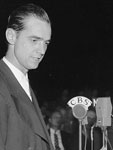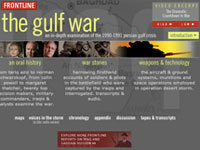This is the third in a series of film reviews reprinted from the Journal of American History. These reviews model ways of looking critically at popular films, documentaries, miniseries, and other history-based features.
Some talented people have the misfortune to enter popular memory in their decrepitude. Howard Hughes's name, when joined with "crazy" or "Las Vegas," produces far more results in an Internet search than when it is joined with "twa" or "Constellation." It is the phobias and the fingernails that most people remember, not the aviation achievements.
The chief virtue of Martin Scorsese's The Aviator is that it restores Hughes to his rightful place as one of America's great aviation visionaries. As in most biopics, messy details are simplified, and characters are conflated or altered. Scorsese and the writer John Logan have reduced complex business deals to spur-of-the-moment decisions and edited out their hero's racism. Hughes liked African Americans about as much as he liked germs, though you would never know it from watching the film. Leonardo DiCaprio plays Hughes as a troubled but socially beneficent hero like those in Ayn Rand's novels. He's Howard Roark, but with more neuroses and ready cash.
As in most biopics, messy details are simplified, and characters are conflated or altered.
By contrast, Scorsese and Logan darken Juan Trippe's character. Alec Baldwin portrays the head of Pan American Airways as a smarmy airline vulture, plotting with meretricious politicians to take over the world's air routes, on display in his posh office. Trippe was a schemer, but he was as concerned with long-term survival as with achieving monopoly. He knew that Pan Am needed domestic feeder routes and that his airline would be at a competitive disadvantage if limited to overseas operations. World War II had left twa (which Hughes renamed Trans World Airlines) in a position to develop both domestic and international routes. Trippe's attempt to use political pressure to force Hughes to sell TWA was, in a business sense, perfectly rational. Had Trippe gotten his way, Pan Am might still be flying.
What Scorsese and Logan get right about aviation history is just as important. They understand the central emotional paradox of Hughes's generation of aviation pioneers. In order to make aviation pay, they had to kill the spirit of adventure that had attracted them to flying in the first place. Hughes loved hot planes. But he knew that attracting paying customers meant making flying as comfortable and risk-free as possible. He worked with manufacturers to develop larger, faster, and more reliable airliners equipped with pressurized cabins. Planes such as the Constellation could fly high above the weather, minimizing drag and airsickness while whisking passengers across the country. Hughes's aggressive pursuit of this vision—he ends the film obsessing about jets as "the way of the future"—helped the airline industry revolutionize long-distance passenger service. Like all revolutions, this one exacted a price. The railroads' Pullman car business died off, as did the romance of flying. Pressurized equipment made the distant landscape seem barely worth a glance from vestigial windows. Bernard DeVoto called cross-country flying "the dullest mode of travel." Many a conference-bound historian has shared the thought.
Like all revolutions, this one exacted a price. The railroads' Pullman car business died off, as did the romance of flying.
One of the contradictions of Hughes's career is that his other youthful obsession, filmmaking, got in the way of making flying a mass business. Hell's Angels (1930), which cost four lives and as many millions of dollars to film, featured colliding planes and stoic airmen plunging to their deaths. Hughes shot so much spectacular footage that the unused film turned up in at least seven other movies, among them Hughes's own Sky Devils(1932). What was good for the box office was not necessarily good for the airlines. Aviation boosters hated the crash-and-burn movies because they reinforced anxieties about flying. If Hughes the technological visionary wanted to expand air travel, Hughes the filmmaker was spitting into the wind. Scorsese gaudily colorizes one of the most notorious scenes in Hell's Angels, that of a pilot burning alive in his cockpit. The gesture may be an acknowledgment of the contradiction, or an ironic reference to Scorsese's own fear of flying, or both.
Youthful, handsome, and tall (the compact DiCaprio makes us forget that Hughes was 6′ 4″), Hughes carried on several affairs with movie stars during his filmmaking career. Scorsese uses these romances and his own encyclopedic knowledge of film history to re-create Hollywood's interwar culture—its nightlife, its gossip industry, its cult of bosomy celebrity. Cate Blanchett does a superb turn as Katharine Hepburn, and Kate Beckinsale wields a sharp wit as Ava Gardner. Hollywood may have been a macho town in the thirties, but The Aviator's leading women are every bit as shrewd and determined as the men. The winds of liberation blow through this film.
Scorsese uses these romances and his own encyclopedic knowledge of film history to re-create Hollywood's interwar culture—its nightlife, its gossip industry, its cult of bosomy celebrity.
So does the hurricane of obsession. Scorsese is fascinated by reckless obsessives, roles Robert De Niro seems to have been born to play. Think of Johnny Boy Civello in Mean Streets (1973) or Jake La Motta in Raging Bull (1980) or Rupert Pupkin in The King of Comedy (1983)—with the twist that, for Pupkin, obsession turns out to be a good career move. Not for Howard Hughes. The only question in the long, last part of the film is whether Hughes will be done in by Trippe and his senatorial lackey, Ralph Owen Brewster (Alan Alda), or whether he will do himself in first. "I see things," Hughes tells Ava Gardner. "I know, baby," she says.
Why did Hughes go around the bend? Scorsese and Logan assign Hughes's germ phobia to his hygiene-obsessed mother, shown bathing young Howard in the film's opening and closing scenes. "You are not safe," she tells him. Hughes lathers up for the rest of his life. In his adolescence, Hughes lost both of his parents and most of his hearing. "People simply don't understand how deaf Howard was," Katharine Hepburn told A. Scott Berg. "It made him terribly detached and a real self-starter. But it also started him down an endlessly lonely path, really cut off from people." DiCaprio brings out Hughes's deafness in subtle ways. He maneuvers close to other characters, studying their faces for clues to the meanings of words he cannot hear. Deafness made it harder to cope with stress, of which Hughes had more than his share. Besides the relentless press attention, he was involved in several car and plane crashes, two of which are spectacularly re-created in the film. The cumulative damage to his body and brain ultimately left him dependent on narcotics. Anyone subjected to as much trauma as Hughes suffered would probably be seeing things too.
The particularities of history recede, the generalities of the human condition advance.
Scorsese uses every tool at his disposal, from lighting to sound editing to choice of film stock, to evoke Hughes's turbulent mental state. This is a technically brilliant and emotionally disturbing film, one in which director, writer, and star conspire to drag us along into the quicksand swamp of obsession. As the hero lines up sterile milk bottles filled with his amber urine, the film gains in psychological intensity but loses in historical interest. If the first hour is about the golden age of Hollywood and the second about the golden age of aviation, the third seems a self-conscious remake of Citizen Kane (1941), featuring Hughes as a cagier version of William Randolph Hearst. The particularities of history recede, the generalities of the human condition advance. The film ends on a universal, if homey, note. When you have your mental health, you have everything.

